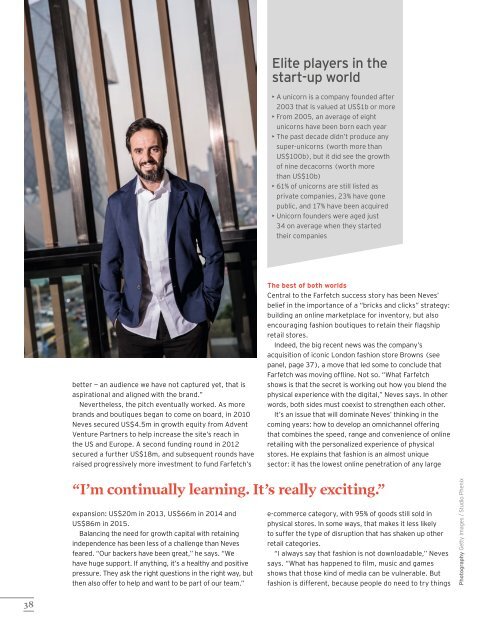Exceptional
ey-exceptional-2016-uki-book
ey-exceptional-2016-uki-book
Create successful ePaper yourself
Turn your PDF publications into a flip-book with our unique Google optimized e-Paper software.
Elite players in the<br />
start-up world<br />
• A unicorn is a company founded after<br />
2003 that is valued at US$1b or more<br />
• From 2005, an average of eight<br />
unicorns have been born each year<br />
• The past decade didn’t produce any<br />
super-unicorns (worth more than<br />
US$100b), but it did see the growth<br />
of nine decacorns (worth more<br />
than US$10b)<br />
• 61% of unicorns are still listed as<br />
private companies, 23% have gone<br />
public, and 17% have been acquired<br />
• Unicorn founders were aged just<br />
34 on average when they started<br />
their companies<br />
better — an audience we have not captured yet, that is<br />
aspirational and aligned with the brand.”<br />
Nevertheless, the pitch eventually worked. As more<br />
brands and boutiques began to come on board, in 2010<br />
Neves secured US$4.5m in growth equity from Advent<br />
Venture Partners to help increase the site’s reach in<br />
the US and Europe. A second funding round in 2012<br />
secured a further US$18m, and subsequent rounds have<br />
raised progressively more investment to fund Farfetch’s<br />
The best of both worlds<br />
Central to the Farfetch success story has been Neves’<br />
belief in the importance of a “bricks and clicks” strategy:<br />
building an online marketplace for inventory, but also<br />
encouraging fashion boutiques to retain their flagship<br />
retail stores.<br />
Indeed, the big recent news was the company’s<br />
acquisition of iconic London fashion store Browns (see<br />
panel, page 37), a move that led some to conclude that<br />
Farfetch was moving offline. Not so. “What Farfetch<br />
shows is that the secret is working out how you blend the<br />
physical experience with the digital,” Neves says. In other<br />
words, both sides must coexist to strengthen each other.<br />
It’s an issue that will dominate Neves’ thinking in the<br />
coming years: how to develop an omnichannel offering<br />
that combines the speed, range and convenience of online<br />
retailing with the personalized experience of physical<br />
stores. He explains that fashion is an almost unique<br />
sector: it has the lowest online penetration of any large<br />
“I’m continually learning. It’s really exciting.”<br />
expansion: US$20m in 2013, US$66m in 2014 and<br />
US$86m in 2015.<br />
Balancing the need for growth capital with retaining<br />
independence has been less of a challenge than Neves<br />
feared. “Our backers have been great,” he says. “We<br />
have huge support. If anything, it’s a healthy and positive<br />
pressure. They ask the right questions in the right way, but<br />
then also offer to help and want to be part of our team.”<br />
e-commerce category, with 95% of goods still sold in<br />
physical stores. In some ways, that makes it less likely<br />
to suffer the type of disruption that has shaken up other<br />
retail categories.<br />
“I always say that fashion is not downloadable,” Neves<br />
says. “What has happened to film, music and games<br />
shows that those kind of media can be vulnerable. But<br />
fashion is different, because people do need to try things<br />
Photography Getty Images / Studio Phenix<br />
38


